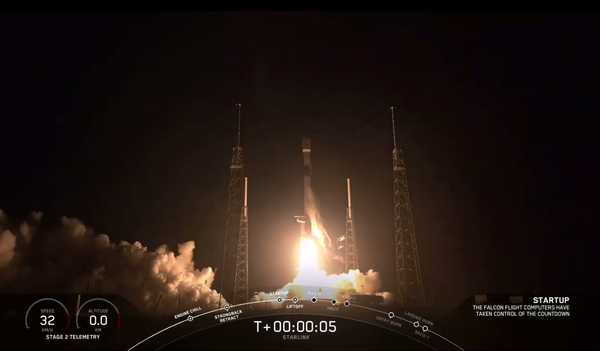Elon Musk’s SpaceX satellites are being sent into orbit so frequently that “it will likely end ground-based astronomy as we know it,” as they prevent scientists from observing the night sky from earth-based observatories uninterrupted, a prominent astrophysicist has written in Forbes.
Theoretical astrophysicist Ethan Siegel warns that Musk risks polluting the night sky with the “Starlink” satellites to a degree when ground-based observatories worth hundreds of millions of dollars could be rendered useless.
Elon Musk’s plan is to build a “mega-constellation” of Starlink satellites potentially numbering 42,000. Siegel writes that though just 122 of these have been launched, the impact on astronomy has already been massive.
“From the darkest skies you can find on Earth, approximately 9,000 stars are visible to human eyes: down to a visual magnitude of +6.5, the limit of human vision. Yet the first 122 satellites launched by Starlink are not only brighter than the majority of these stars, they move quickly throughout the sky, leaving trails that pollute astronomers’ data,” writes the scientist.
Previous constellations of Satellites, writes Siegel, “proceeded in clearly defined and predictable orbits, were few in number, and only flared brightly when their orientation reflected sunlight in a particular manner.”
Siegel cites an incident in September in which the European Space Agency had to move one of its satellites out of the way to protect it from colliding with a SpaceX Starlink satellite.
For the first time ever, ESA has performed a 'collision avoidance manoeuvre' to protect one of its satellites from colliding with a 'mega constellation'#SpaceTraffic pic.twitter.com/kmXvAgpj1U
— ESA Operations (@esaoperations) September 2, 2019
SpaceX and Elon Musk have issued statements saying its satellites will not significantly impact astronomy, that it will reduce the albedo (brightness) of its satellites, and that it will adjust orientation on demand for astronomical experiments.
“All of these statements are not yet true as of November 20, 2019,” writes Siegel.
“Debilitating threat” to astronomical infrastructures
Starlink is a satellite constellation conceived by American company SpaceX to provide Internet access and set to comprise thousands of small satellites, working in combination with ground transceivers.
As of November 2019, SpaceX has deployed 122 satellites, with a total of nearly 12,000 satellites to be deployed by the mid-2020s. The number may possibly be extended to 42,000.
The mega-constellation project has generated grave concerns in the scientific community.

After the first batch was deployed, the International Astronomical Union issued a statement saying that such constellations “can pose a significant or debilitating threat to important existing and future astronomical infrastructures.”
Astronomers have been also concerned about the constellation’s effect on the $466 million Large Synoptic Survey Telescope (LSST), one of the world’s most new important telescopes currently being built on the Cerro Pachón ridge in Chile’s Elqui Valley.
Check out this amazing photo of the total solar eclipse today, taken near the @LSST observatory on Cerro Pachón by our very own @EarthCam #NSFScience pic.twitter.com/nfFf9yAe7J
— LSST Astronomy (@LSST) July 2, 2019
The LSST’s decade-long survey of the night sky is due to begin in 2022 to catalog 40 billion celestial objects by 2032.

The US National Radio Astronomy Observatory and the Green Bank Observatory likewise conveyed their concerns to SpaceX.
Elon Musk responded in late May that he had requested Starlink designers to make their satellites less reflective, with the company reportedly pledging to paint the Earth-facing side of its satellites black.


